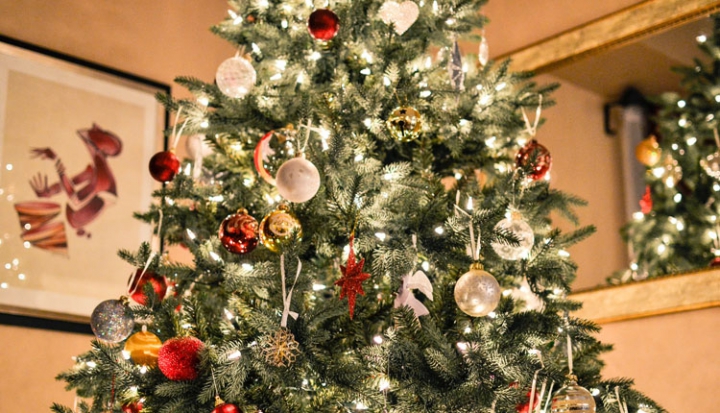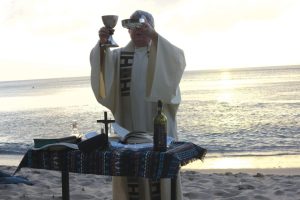Every family celebrates the Christmas season a little differently. Some make a point of chopping down their own Christmas tree, while others find joy in baking Christmas cookies together. Some always attend midnight Mass on Christmas Eve, while others wait until Christmas Day to go to church. Christmas traditions—whatever they may be—are sacred because they bring families together in fellowship to celebrate the incarnation. And for the 189 U.S. Catholic readers who participated in our survey, preserving and handing down these traditions is almost as important as Jesus’ miraculous birth.
Christmas Mass brings people together liturgically and as families. For many U.S. Catholic survey participants, it’s not a question of if their family will attend Mass but when. Our results show a fairly even split among those who attend Mass during the day on Christmas Eve (29 percent), midnight Mass on Christmas Eve (41 percent), and Mass on Christmas Day (37 percent). While some readers cite scheduling around family and children as the reason they attended one service over another, others made more intentional choices. “My husband and I have celebrated midnight Mass together every year since we were engaged 43 years ago. When our four children were young, we would take them to the late afternoon Mass first,” says Nancy Dome of Hudson, Massachusetts. “Then, we were fortunate enough to have family who stayed with them while we went back to midnight Mass.”
Christmas traditions for U.S. Catholic readers extend far beyond the sanctuary—but not too far from the table. Many readers’ celebrations stem from their various ethnic and cultural backgrounds, most of the time anchored in specific food prepared during the holidays. From nibbling on Christmas cookies throughout the month of December to preparing multicourse meals on Christmas Day, food is central to many readers’ Christmas celebrations.
Every year the family of Matthew Martinez of Hammond, Indiana “gives away homemade, warm tamales to our church family at midnight Mass.” Likewise, for Karen Karn of Plymouth, Minnesota, her family “loves to make all the Scandinavian sweets of my husband’s heritage: sandbakelse, krumkake, spritz, and rosettes.” For some, it’s a certain food that truly gets them into the Christmas spirit, like “German stollen from the Christkindlmarket in downtown Chicago,” which readers like Jeanie Lewis from Chicago purchase year after year. For others, it’s a special food that brings their family together. Helene Langan of Schoharie, New York says her family’s Polish tradition is “passing around the oplatek (Christmas wafers) when we have our family Christmas party. It gives us a chance to give each other good wishes and share good news of the family that happened during the year.”
Some families blend cultural Christmas traditions. Mary Knepple of Mattoon, Illinois “used to make glögg and have a little bit of pickled herring on a Triscuit Christmas Eve. My mother makes a cardamom-spiced Swedish coffee cake for Christmas breakfast. And now my nephew’s wife, who is Latina, has brought her lovely culture into the mix. We’re a melting pot.” Likewise, Carol Ruddell of Sandy, Utah says her family does it all: “We have a German Christmas tree with a pickle and spider to find. We have Mexican luminaria to highlight the drive and walkway. And we have Italian for Christmas Eve dinner.”
U.S. Catholic readers are proud to celebrate their heritage through food around Christmastime. They’re also proud of traditions created within their families that don’t have any significance outside their families. Dana D’Avella of Rockville, Maryland recalls her favorite Christmas tradition growing up. “The ‘Christmas Mouse’ would leave a present for us to open on Christmas Eve morning,” she says. “The present was always new pajamas that we could wear to bed on Christmas Eve. It has been a tradition that we have passed on to our children and still, even with teenagers, carry on each year. It means even more now that my dad is no longer here to celebrate with us.”
DeDe Styrsky of Fort Worth also celebrates Christmas in a unique way with her children and grandchildren. “When my girls were young, we had Christmas craft parties every year,” she says. “They invited their classmates and we made different kinds of ornaments. I have continued the tradition with my granddaughters who always look forward to it.”
Many readers revere the religious practices that remind them of the birth of Christ. Ronald Hunter of Milwaukee always lights “a candle in the window to celebrate the light of Christ in the home and a welcome sign for the traveler.” Monica Stratton, who lives in Fairfield, Pennsylvania, loves “reading the nativity stories in the Bible on Christmas Eve evening.” And Kathleen Myles of Saginaw, Michigan always sets up a nativity scene but doesn’t “put baby Jesus in the crib until Christmas morning” and then “moves the wise men closer to the nativity scene daily until Epiphany.”
Myles hits on an important element of U.S Catholic readers’ Christmas celebrations: They last beyond Christmas Eve and Christmas Day. Liturgically, the Christmas season extends from Christmas Eve until the feast of the baptism of Jesus, but many survey participants say Advent and other feast days are central to their holiday rituals. Fifty-one percent of respondents celebrate the feast of St. Nicholas on December 6, leaving their shoes out for St. Nick to put presents in. Liz Croddy of Colorado Springs, Colorado, loves celebrating St. Nicholas because it reminds her of her Dutch heritage. “As an adult I have become super enthusiastic about St. Nick, and I love to tell others the story about the real Santa,” she says. “I admire the Dutch for separating present-giving on December 6 from the religious celebration on December 25.”
An even more widespread holiday celebrated by U.S. Catholic survey participants is the Epiphany—or the recognition of the three wise men reaching Jesus—on January 6, with 75 percent of participants recognizing this as an important day for their family. Don Brunner of Phoenix notes that he believes we should “celebrate the season as many other cultures do by keeping December 25 as a religious celebration and then exchange gifts on the feast of the three kings.”
Other noteworthy Christmas holidays for readers are Las Posadas, a nine-day reenactment of Mary and Joseph’s search for lodging, common in Mexican-American communities, that begins on December 16; St. Lucia day, a traditional Swedish celebration on December 13; the feast of the Holy Innocents commemorating the children murdered by King Herod as he attempted to kill the baby Jesus celebrated on December 28; and the Solemnity of Mary, the Mother of God on January 1. Some readers even integrate the birth or death of a loved one into their annual Christmas celebrations. In celebrating other holidays during the month of December,
Elizabeth Kelly of Miami admits she “tries to make Christmas last as long as possible.” From attending Christmas Mass to sharing food with family during the holiday season, the ways in which people celebrate Christmas reflect the beautiful diversity within the church. Father Mark Francis, president of Catholic Theological Union and widely respected for his work in liturgical studies, recognizes the importance of these traditions because they help us remember “that God comes into our world. God is not just an abstraction but comes into our world and lives with us.”

This article also appears in the December 2016 issue of U.S. Catholic (Vol. 81, No. 12, pages 33–37).














Add comment